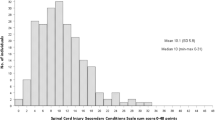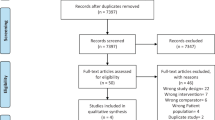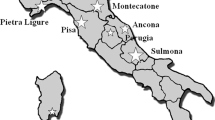Abstract
Study design
Cross-sectional analysis of baseline data of a longitudinal cohort study.
Objectives
Little evidence exists on pain-related psychosocial factors in individuals with newly acquired spinal cord injury (SCI). To understand a biopsychosocial model of pain, we must first understand the presenting psychological pain-related factors at injury onset. Therefore, we assessed musculoskeletal pain and pain-related psychological constructs in a group of individuals with newly acquired SCI. We hypothesized that individuals with new SCI would report musculoskeletal shoulder pain with elevated levels of kinesiophobia and pain catastrophizing.
Setting
Data were collected in three rehabilitation hospitals located in urban and suburban communities.
Methods
Thirty-five individuals with newly acquired SCI participated. Demographics, Musculoskeletal Pain Survey shoulder subscale, Tampa Kinesiophobia Scale-11, Pain Catastrophizing Scale, Fear of Pain Questionnaire, Chronic Pain Coping Inventory-42, and Subjective Quality of Life Questionnaire were administered. Descriptive analysis of all measures was determined and relationships between pain and psychosocial measures determined.
Results
Moderate shoulder pain existed in 40% of people with new SCI along with clinically elevated kinesiophobia, pain catastrophizing, fear of pain, and reduced quality of life. Shoulder pain was statistically associated with pain catastrophizing (ρ = 0.41, p = 0.01). Kinesiophobia positively correlated with fear of pain (ρ = 0.38, p = 0.02) with an inverse relationship to quality of life (ρ = −0.47, p = 0.01).
Conclusions
Elevated pain, and pain-related psychological characteristics, such as catastrophizing and kinesiophobia exist during the early stages after SCI. Early identification of pain-related factors can guide clinical intervention potentially ameliorating pain-linked functional impairments.
Trial registry
This trial is registered with ClinTrial.gov ID NCT03137394.
Similar content being viewed by others
Log in or create a free account to read this content
Gain free access to this article, as well as selected content from this journal and more on nature.com
or
Data availability
The datasets generated during and/or analyzed during the current study are available from the corresponding author on reasonable request.
References
National Spinal Cord Injury Statistical Center. Facts and figures at a glance. Birmingham, AL: University of Alabama at Birmingham; 2019.
Lysack C, Komanecky M, Kabel A, Cross K, Neufeld S. Environmental factors and their role in community integration after spinal cord injury. Can J Occup Ther. 2007;74:243–54.
Sie IH, Waters RL, Adkins RH, Gellman H. Upper extremity pain in the postrehabilitation spinal cord injured patient. Arch Phys Med Rehabil. 1992;73:44–8.
Filardo G, Roffi A, Merli G, Marcacci T, Ceroni FB, Raboni D, et al. Patient kinesiophobia affects both recovery time and final outcome after total knee arthroplasty. Knee Surg Sports Traumatol Arthrosc. 2016;24:3322–8.
Ishak NA, Zahari Z, Justine M. Kinesiophobia, pain, muscle functions, and functional performances among older persons with low back pain. Pain Res Treat. 2017;2017:3489617.
Wollaars MM, Post MW, van Asbeck FW, Brand N. Spinal cord injury pain: the influence of psychologic factors and impact on quality of life. Clin J Pain. 2007;23:383–91.
Sullivan MJL, Bishop SR, Pivik J. The pain catastrophizing scale: development and validation. Psychol Assess. 1995;7:524–32.
Petrak F, Hardt J, Kappis B, Nickel R, Tiber Egle U. Determinants of health-related quality of life in patients with persistent somatoform pain disorder. Eur Jouranl Pain. 2003;7:463–71.
Goubert L, Francken G, Crombez G, Vansteenwegen D, Lysens R. Exposure to physical movement in chronic back pain patients: no evidence for generalization across different movements. Behav Res Ther. 2002;40:415–29.
Ullrich PM, Jensen MP, Loeser JD, Cardenas DD, Weaver FM. Pain among veterans with spinal cord injury. J Rehabil Res Dev. 2008;45:793–800.
Lethem J, Slade P, Troup J, Bentley G. Outline of a fear—avoidance model of exaggerated pain perception—I. Behavorial Res Ther. 1983;21:401–8.
George SZ, Dover GC, Wallace MR, Sack BK, Herbstman DM, Aydog E, et al. Biopsychosocial influence on exercise-induced delayed onset muscle soreness at the shoulder: pain catastrophizing and catechol-o-methyltransferase (comt) diplotype predict pain ratings. Clin J Pain. 2008;24:793–801.
Kori S, Miller R, Todd D. Kinesiophobia: a new view of chronic pain behavior. Pain Manag. 1990;3:35–43.
Das DeS, Vranceanu AM, Ring DC. Contribution of kinesophobia and catastrophic thinking to upper-extremity-specific disability. J Bone Jt Surg Am. 2013;95:76–81.
Finley MA, Euiler E. Association of psychosocial factors, musculoskeletal pain, and activity in manual wheelchair users: A pilot study. J Spinal Cord Med. 2020;43:497–504. https://doi.org/10.1080/10790268.2019.1565717.
Leung L. Pain catastrophizing: an updated review. Indian J Psychol Med. 2012;34:204–17.
Hanley MA, Raichle K, Jensen M, Cardenas DD. Pain catastrophizing and beliefs predict changes in pain interference and psychological functioning in persons with spinal cord injury. J Pain. 2008;9:863–71.
Kirshblum S, Waring W 3rd. Updates for the international standards for neurological classification of spinal cord injury. Phys Med Rehabil Clin N Am. 2014;25:505–17.
Kirshblum SC, Burns SP, Biering-Sorensen F, Donovan W, Graves DE, Jha A, et al. International standards for neurological classification of spinal cord injury (revised 2011). J Spinal Cord Med. 2011;34:535–46.
Finley M, Euiler E, Trojian T, Gracely E, Schmidt-Read M, Frye SK, et al. Shoulder impairment and pain of individuals with newly acquired spinal cord injury compared to uninjured peers. Spinal Cord Ser Cases. 2020;6:68.
van Drongelen S, de Groot S, Veeger HE, Angenot EL, Dallmeijer AJ, Post MW, et al. Upper extremity musculoskeletal pain during and after rehabilitation in wheelchair-using persons with a spinal cord injury. Spinal Cord. 2006;44:152–9.
Eriks-Hoogland I, de Groot S, Snoek G, Stucki G, Post M, van der Woude L. Association of shoulder problems in persons with spinal cord injury at discharge from inpatient rehabilitation with activities and participation 5 years later. Arch Phys Med Rehabil. 2016;97:84–91.
Eriks-Hoogland IE, de Groot S, Post MW, van der Woude LH. Passive shoulder range of motion impairment in spinal cord injury during and one year after rehabilitation. J Rehabil Med. 2009;41:438–44.
Eriks-Hoogland IE, Hoekstra T, de Groot S, Stucki G, Post MW, van der Woude LH. Trajectories of musculoskeletal shoulder pain after spinal cord injury: identification and predictors. J Spinal Cord Med. 2014;37:288–98.
Woby SR, Roach NK, Urmston M, Watson PJ. Psychometric properties of the TSK-11: a shortened version of the tampa scale for kinesiophobia. Pain. 2005;117:137–44.
Vlaeyen JW, Kole-Snijders AM, Rotteveel AM, Ruesink R, Heuts PH. The role of fear of movement/(re)injury in pain disability. J Occup Rehabil. 1995;5:235–52.
McNeil DW, Kennedy SG, Randall CL, Addicks SH, Wright CD, Hursey KG, et al. Fear of pain questionnaire-9: Brief assessment of pain-related fear and anxiety. Eur J Pain. 2018;22:39–48.
Sullivan MJL. The pain catastrophizing scale: user manual. Montreal: McGill University; 2009. p. 1–36.
Osman A, Barrios FX, Kopper BA, Hauptmann W, Jones J, O’Neill E. Factor structure, reliability, and validity of the pain catastrophizing scale. J Behav Med. 1997;20:589–605.
Kemp BJ, Etelson D. Quality of life while aging with spinal cord injury and other impairments. Top Spinal Cord Inj Rehabil. 2001;6:116–27.
Jensen MP, Turner JA, Romano JM, Strom SE. The chronic pain coping inventory: development and preliminary validation. Pain. 1995;60:203–16.
Romano JM, Jensen MP, Turner JA. The chronic pain coping inventory-42: reliability and validity. Pain. 2003;104:65–73.
Cohen J. Statistical power analysis for the behavioral sciences. 32nd ed. Hillsdale, NJ: Lawrence Erlbaum Associates; 1988.
Siddall PJ, Taylor DA, McClelland JM, Rutkowski SB, Cousins MJ. Pain report and the relationship of pain to physical factors in the first 6 months following spinal cord injury. Pain. 1999;81:187–97.
Murray RF, Asghari A, Egorov DD, Rutkowski SB, Siddall PJ, Soden RJ, et al. Impact of spinal cord injury on self-perceived pre- and postmorbid cognitive, emotional and physical functioning. Spinal Cord. 2007;45:429–36.
Silvestri J. Effects of chronic shoulder pain on quality of life and occupational engagement in the population with chronic spinal cord injury: preparing for the best outcomes with occupational therapy. Disabil Rehabil. 2017;39:82–90.
McCracken LM. Learning to live with the pain: acceptance of pain predicts adjustment in persons with chronic pain. Pain. 1998;74:21–7.
Westman AE, Boersma K, Leppert J, Linton SJ. Fear-avoidance beliefs, catastrophizing, and distress: a longitudinal subgroup analysis on patients with musculoskeletal pain. Clin J Pain. 2011;27:567–77.
Linton SJ. A review of psychological risk factors in back and neck pain. Spine (Philos Pa 1976). 2000;25:1148–56.
Filardo G, Merli G, Roffi A, Marcacci T, Berti Ceroni F, Raboni D, et al. Kinesiophobia and depression affect total knee arthroplasty outcome in a multivariate analysis of psychological and physical factors on 200 patients. Knee Surg Sports Traumatol Arthrosc. 2017;25:3417–23.
Roelofs J, Sluiter JK, Frings-Dresen MH, Goossens M, Thibault P, Boersma K, et al. Fear of movement and (re)injury in chronic musculoskeletal pain: evidence for an invariant two-factor model of the tampa scale for kinesiophobia across pain diagnoses and dutch, swedish, and canadian samples. Pain. 2007;131:181–90.
Osman A, Barrios FX, Gutierrez PM, Kopper BA, Merrifield T, Grittmann L. The pain catastrophizing scale: Further psychometric evaluation with adult samples. J Behav Med. 2000;23:351–65.
Molton IR, Stoelb BL, Jensen MP, Ehde DM, Raichle KA, Cardenas DD. Psychosocial factors and adjustment to chronic pain in spinal cord injury: replication and cross-validation. J Rehabil Res Dev. 2009;46:31–42.
Raichle KA, Hanley M, Jensen MP, Cardenas DD. Cognitions, coping, and social environment predict adjustment to pain in spinal cord injury. J Pain. 2007;8:718–29.
Kemp B, Tsukerman D, Kahan J, Adkins R. Predicting psychosocial outcomes using a brief measure of quality of life in a sample of people with spinal cord injury. Top Spinal Cord Inj Rehabil. 2014;20:191–6.
Acknowledgements
We would like to thank Sara Mulroy, PT, PhD for her consultation on recruitment and outcome interpretation during this project.
Funding
This work was supported by the Department of Defense, through the Spinal Cord Injury Research Program Investigator-Initiated Research Award under Award No. W81XWH-17-1-0476.
Author information
Authors and Affiliations
Contributions
MF as overall study PI was responsible for all aspects of the project from design, data collection, analysis, and manuscript preparation. EE was responsible for data collection at the Drexel site, data entry analysis, and manuscript preparation. LB was responsible for data analysis and interpretation of psychosocial measures, analysis, and manuscript preparation. EG was the primary biostatistician responsible for data analysis, interpretation, and manuscript preparation. MB was responsible for recruitment, screening, and data collection at GSRH, interpretation of outcomes and manuscript review. MS-R was responsible for recruitment and screening of participants from Magee (Drexel site), ongoing consultation on outcomes and manuscript review. SKF, MK, and AS were responsible for recruitment, data collection at University of Maryland site, and manuscript review. HY was site PI at University of Maryland and was responsible for study design, guided recruitment, and data collection, analysis, and manuscript review. PRG was responsible for study design, data collection at University of Maryland, data interpretation, and manuscript review.
Corresponding author
Ethics declarations
Conflict of interest
The authors declare no competing interests.
Ethics approval
The U.S. Army Medical Research and Development Command (USAMRDC), Office of Research Protections (ORP), Human Research Protection Office (HRPO) approved the protocol on Log Number SC160041, Award Number W81XWH-17-1-0476, HRPO Log Number A-20222.a.,b.,.c.,d. Individual Institutional Review Board approval was received from Drexel University, University of Maryland Magee Rehabilitation Hospital and Good Shepherd Rehabilitation Hospital. We certify that all applicable institutional and governmental regulations concerning the ethical use of human volunteers were followed during this research.
Additional information
Publisher’s note Springer Nature remains neutral with regard to jurisdictional claims in published maps and institutional affiliations.
Rights and permissions
About this article
Cite this article
Finley, M., Euiler, E., Baehr, L. et al. Relationship of psychosocial factors and musculoskeletal pain among individuals with newly acquired spinal cord injury. Spinal Cord Ser Cases 7, 61 (2021). https://doi.org/10.1038/s41394-021-00415-4
Received:
Revised:
Accepted:
Published:
DOI: https://doi.org/10.1038/s41394-021-00415-4



